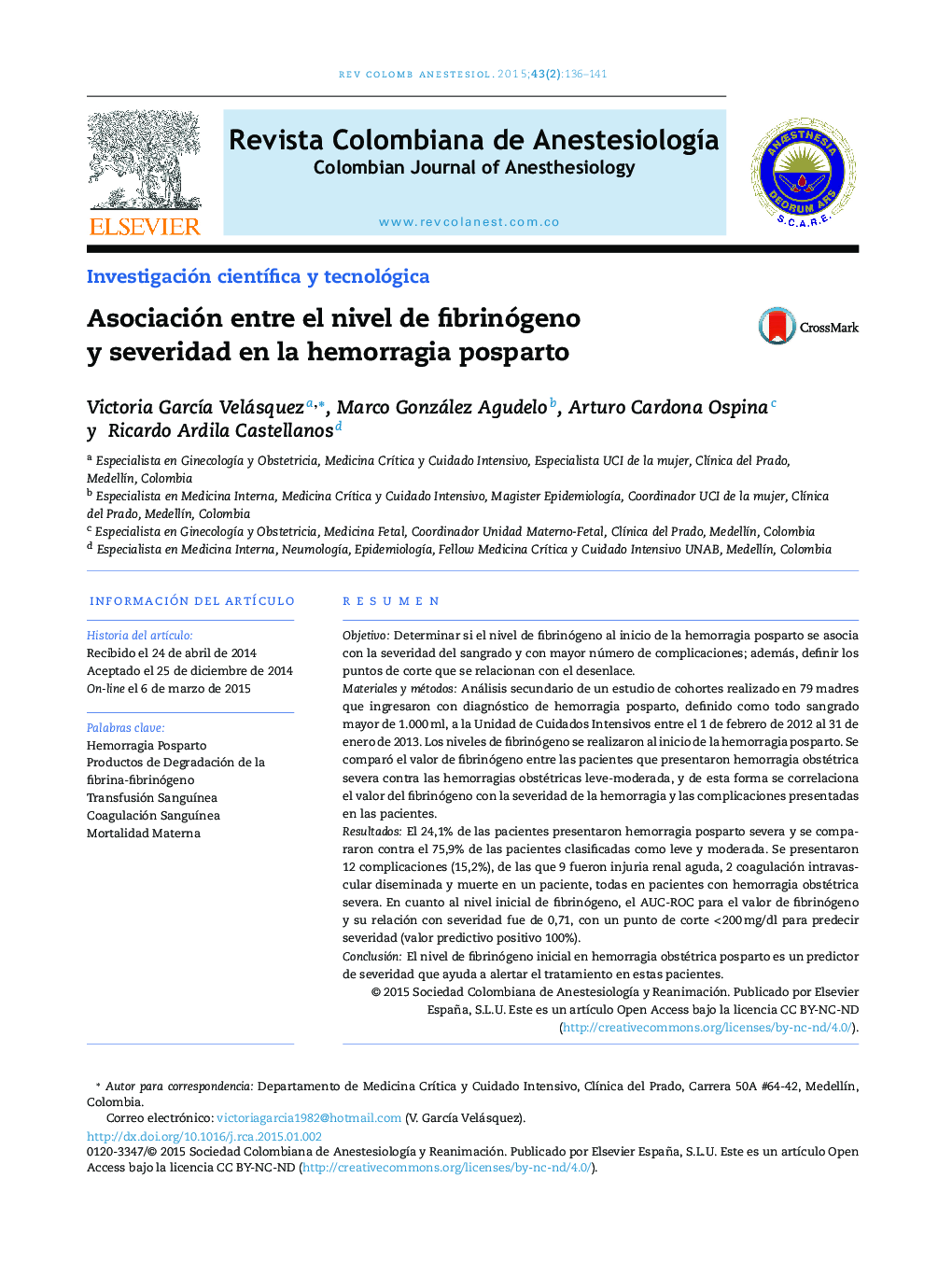| Article ID | Journal | Published Year | Pages | File Type |
|---|---|---|---|---|
| 2767831 | Revista Colombiana de Anestesiología | 2015 | 6 Pages |
ResumenObjetivoDeterminar si el nivel de fibrinógeno al inicio de la hemorragia posparto se asocia con la severidad del sangrado y con mayor número de complicaciones; además, definir los puntos de corte que se relacionan con el desenlace.Materiales y métodosAnálisis secundario de un estudio de cohortes realizado en 79 madres que ingresaron con diagnóstico de hemorragia posparto, definido como todo sangrado mayor de 1.000 ml, a la Unidad de Cuidados Intensivos entre el 1 de febrero de 2012 al 31 de enero de 2013. Los niveles de fibrinógeno se realizaron al inicio de la hemorragia posparto. Se comparó el valor de fibrinógeno entre las pacientes que presentaron hemorragia obstétrica severa contra las hemorragias obstétricas leve-moderada, y de esta forma se correlaciona el valor del fibrinógeno con la severidad de la hemorragia y las complicaciones presentadas en las pacientes.ResultadosEl 24,1% de las pacientes presentaron hemorragia posparto severa y se compararon contra el 75,9% de las pacientes clasificadas como leve y moderada. Se presentaron 12 complicaciones (15,2%), de las que 9 fueron injuria renal aguda, 2 coagulación intravascular diseminada y muerte en un paciente, todas en pacientes con hemorragia obstétrica severa. En cuanto al nivel inicial de fibrinógeno, el AUC-ROC para el valor de fibrinógeno y su relación con severidad fue de 0,71, con un punto de corte < 200 mg/dl para predecir severidad (valor predictivo positivo 100%).ConclusiónEl nivel de fibrinógeno inicial en hemorragia obstétrica posparto es un predictor de severidad que ayuda a alertar el tratamiento en estas pacientes.
ObjectiveTo determine if the level of fibrinogen at the onset of postpartum haemorrhage is associated with bleeding severity and a higher number of complications; to determine outcome-related cut-off points.Materials and methodsSecondary analysis of a cohort study conducted with 79 mothers admitted to the Intensive Care Unit between February 1st, 2012 and January 31st, 2013, with a diagnosis of postpartum haemorrhage, defined as all cases of blood loss greater than 1000 mL. Fibrinogen levels were measured at the onset of the postpartum haemorrhage. Fibrinogen values were compared between patients with severe obstetric bleeding and those with mild-to-moderate bleeding, in order to establish the correlation with severity of blood loss and complications.ResultsOverall, 24.1% of the patients showed severe postpartum haemorrhage compared to 75.9% of the patients classified as having mild-to-moderate haemorrhage. There were 12 complications (15.2%), including 9 cases of acute renal injury, 2 cases of disseminated intravascular coagulation, and one death, all of them only in patients with severe obstetric haemorrhage. Regarding the initial fibrinogen value, the AUC-ROC for fibrinogen levels and their relationship with the severity was 0.71, with a cut-off point of < 200 mg/dL to predict severity (100% positive predictive value).ConclusionThe initial fibrinogen level in obstetric postpartum haemorrhage is a predictor of severity that helps in alerting to the need for treatment in these patients.
